
All Solutions

Explore all the solutions you can create with Paperform: surveys, quizzes, tests, payment forms, scheduling forms, and a whole lot more.
See all solutions











Connect with over 2,000 popular apps and software to improve productivity and automate workflows
See all integrationsProducts
Solutions
All Solutions

Explore all the solutions you can create with Paperform: surveys, quizzes, tests, payment forms, scheduling forms, and a whole lot more.
See all solutionsIntegrations

Connect with over 2,000 popular apps and software to improve productivity and automate workflows
See all integrationsResources
Typeform vs. SurveyMonkey: which is better in 2024?

This blog post compares Typeform and SurveyMonkey, highlighting their distinct features and user experiences in form building. Key aspects to consider in a form builder are ease of use, customization, data analysis, integrations, support, pricing, and security. Typeform excels in customizable, user-centric design and engaging forms, while SurveyMonkey offers robust data analysis and security compliance. The post also introduces Paperform as an alternative, balancing Typeform's design appeal and SurveyMonkey's analytical depth, with user-friendly interfaces and comprehensive features.
Your choice of form builder is pivotal in determining the quality of data you gather. Typeform and SurveyMonkey are two leading contenders, each boasting distinct features and user experiences. But how do you decide which one is right for your needs?
In our comparison of Typeform vs. SurveyMonkey, we'll dissect the nuances of these platforms, covering everything from their design and data analysis capabilities to their top features, integrations, and customer support, to help you make an informed decision.
What to look for in a form builder?
Selecting a form builder is more than just picking a tool; it's about finding a partner that aligns with your goals and simplifies your data collection process. Here are key aspects to consider when choosing your form builder:
- Ease of use: The ideal form builder should have an intuitive interface that doesn’t require a steep learning curve. Look for a platform that simplifies form creation, making it accessible even for those with minimal technical expertise.
- Customization options: Your form should be a reflection of your brand. A good form builder offers robust customization options, allowing you to tailor the look and feel of your forms to match your brand identity.
- Data analysis: The value of a form builder lies in its ability to collect and analyze data efficiently. Opt for a tool that provides comprehensive analytics and reporting features, enabling you to draw actionable insights from your data.
- Integrations: Your form builder should seamlessly integrate with other tools and platforms you use. This connectivity ensures a smoother workflow and enhanced functionality.
- Support and resources: Even the most user-friendly tool can present challenges. Choose a platform that offers reliable customer support, along with resources like tutorials, guides, and community forums.
- Pricing: Budget is always a consideration. Evaluate the pricing structure of the form builder to ensure it offers value for money. Be wary of hidden costs and assess what features are included at each pricing tier.
- Security and compliance: Ensure your chosen platform adheres to data protection regulations and offers robust security features to safeguard your and your respondents’ data.
By keeping these factors in mind, you can choose a form builder that not only meets your immediate needs but also supports your long-term objectives.
Typeform vs. SurveyMonkey at a glance
*Available on paid plans only.
Typeform vs. SurveyMonkey: Features
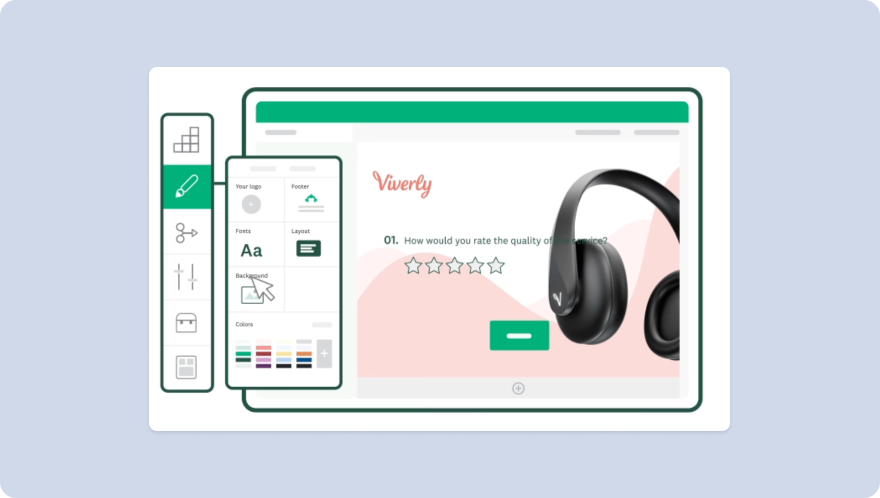 Source: SurveyMonkey
Source: SurveyMonkeyTypeform is renowned for its highly customizable and user-centric design. It shines in creating engaging, interactive forms that can captivate respondents. With its wide array of creative question types and designable welcome screens, Typeform transforms standard surveys into a more dynamic experience.
This level of customization, combined with the ability to integrate professional media like videos and photos, makes Typeform a go-to for those prioritizing aesthetics and user engagement.
However, while Typeform offers basic reporting tools, it may fall short for users seeking in-depth data analysis capabilities.
On the other hand, SurveyMonkey excels in providing a robust, survey-focused platform. It's particularly strong in data analysis and reporting, offering detailed insights that can be crucial for comprehensive market research or feedback collection.
SurveyMonkey's strength lies in its ability to create detailed surveys, supported by a strong backbone of data security and compliance with standards like PCI, HIPAA, GDPR, and WCAG 2.1.
While it may not match Typeform in terms of design flexibility, it compensates with its analytical depth and a range of standard question types suitable for varied survey needs.
Your choice between Typeform and SurveyMonkey might ultimately come down to what you prioritize more: engaging design and user experience or robust data collection and analysis capabilities.
Typeform vs. SurveyMonkey: Design tools
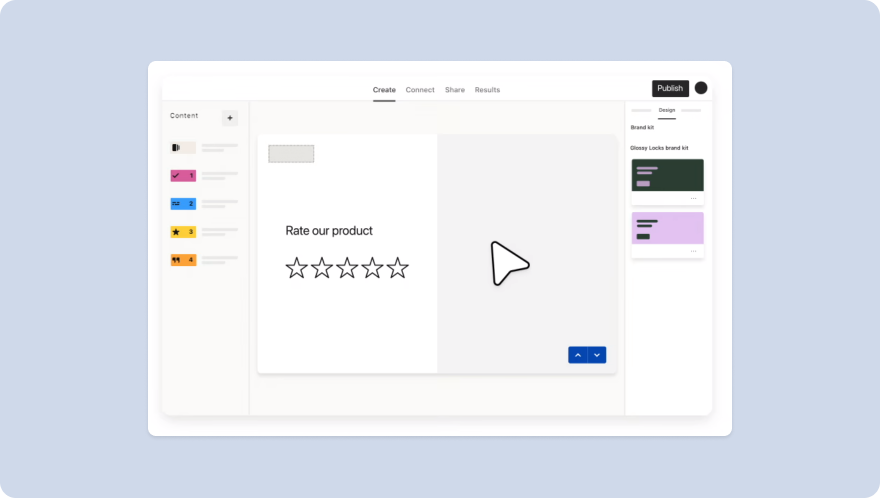 Source: Typeform
Source: TypeformTypeform is celebrated for its design-forward approach. It provides a highly intuitive interface that allows for extensive customization, enabling users to create forms that are not only functional but also visually appealing.
Typeform's strength lies in its ability to create an engaging user experience through aesthetically pleasing layouts and smooth, conversational flows.
This platform is particularly adept at crafting surveys and forms that feel more like a natural conversation, which can be a key factor in increasing completion rates.
The addition of professional media, such as videos and photos from external sources like Pexels and Unsplash, further enhances the visual appeal of Typeform's forms.
SurveyMonkey, while offering a more traditional approach to form design, still provides a solid range of customization options. Its focus is more on functionality and clarity, ensuring that users can create surveys that are easy to navigate.
While SurveyMonkey might not offer the same level of design finesse as Typeform, it compensates with its user-friendly interface and practical design elements. This makes it a reliable choice if you prioritize simplicity and ease of use.
Typeform vs. SurveyMonkey: Data analysis
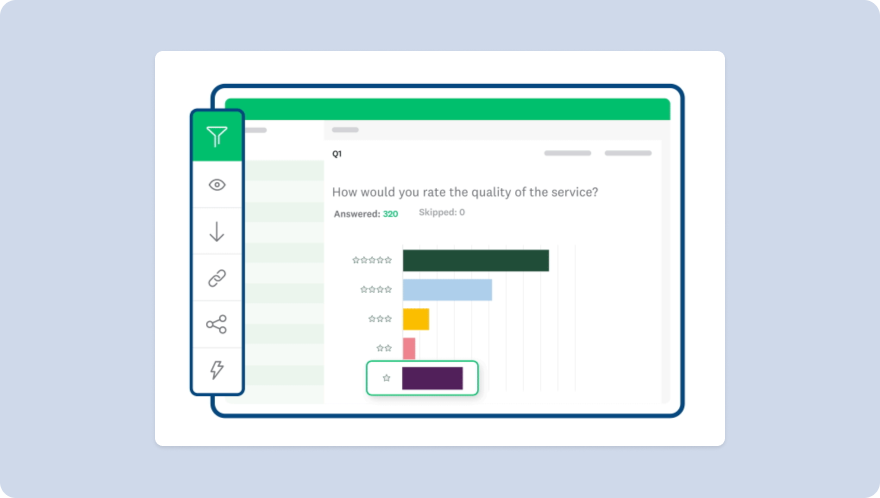 Source: SurveyMonkey
Source: SurveyMonkeyTypeform offers basic reporting tools that are intuitive and easy to navigate, making it suitable for users who need straightforward data insights without extensive analytical capabilities.
Typeform's analytics are designed to give a quick overview of survey results, which can be ideal for less complex data collection needs or for users who prefer simplicity in data interpretation.
SurveyMonkey stands out with its advanced data analysis features. It is well-suited for users who require in-depth analysis and detailed reporting. SurveyMonkey provides a comprehensive set of tools for slicing and dicing data, including cross-tabulation, filters, and various analytical widgets.
This level of depth makes it a powerful tool for market researchers, educators, and businesses that need to derive complex insights from their survey data.
The platform's strength in data analysis ensures that users can not only collect responses but also gain meaningful insights that can inform decision-making and strategy.
Typeform vs. SurveyMonkey: Integrations
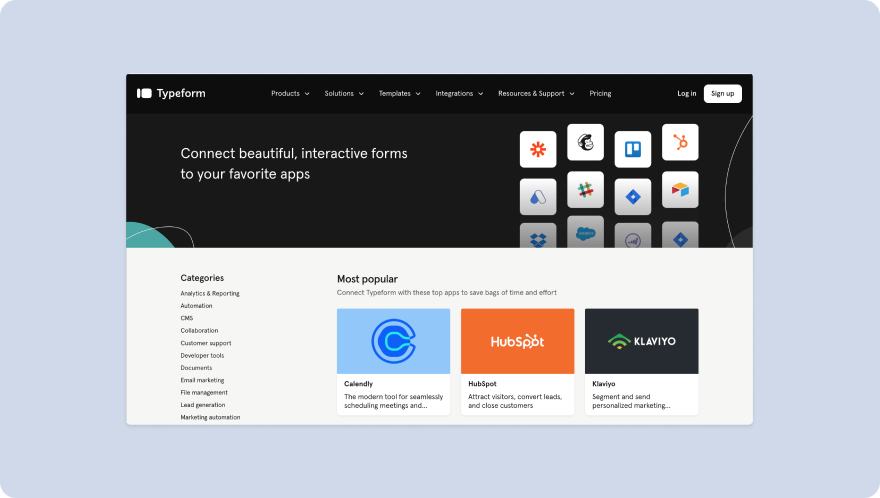 Source: Typeform
Source: TypeformBoth Typeform and SurveyMonkey offer first and third-party integrations, but they cater to different needs and preferences.
Typeform boasts a solid selection of integrations, especially with CRM tools, email marketing platforms, and various productivity apps. These integrations are designed to streamline workflows and enhance the functionality of your forms.
For instance, you can connect Typeform with HubSpot to automatically update customer information or integrate it with email marketing services to enhance your campaigns.
The platform's focus on seamless integration helps in automating processes, saving time and effort for users who rely on multiple digital tools for their business operations.
SurveyMonkey, meanwhile, offers an extensive array of integration options, arguably more diverse than Typeform.
It connects with a wide range of services, including advanced CRM systems, marketing tools, and even more specialized software like analytics and data processing tools.
This makes SurveyMonkey a versatile choice for businesses and organizations that require complex integration ecosystems.
The platform's ability to fit into various digital environments and work in tandem with other tools adds a layer of efficiency and effectiveness to data collection and analysis processes.
Typeform vs. SurveyMonkey: Customer support
 Source: SurveyMonkey
Source: SurveyMonkeyTypeform provides a solid support system with email and chat options, catering to users who need assistance with the platform.
The support is known for being responsive and helpful, offering solutions and guidance to users facing challenges.
Additionally, Typeform has a comprehensive knowledge base filled with useful articles, tutorials, and FAQs that can help users troubleshoot common issues and learn how to make the most of the platform’s features.
SurveyMonkey offers a more extensive support system, including phone support in addition to email and chat.
SurveyMonkey's support extends to a well-organized help center, community forums, and a range of online resources.
These resources provide valuable insights and tips for both new and advanced users, ensuring that help is readily available whenever it's needed.
Typeform vs SurveyMonkey: which do you choose?
Deciding between Typeform and SurveyMonkey can be a bit of a puzzle, depending on your specific needs and the nature of your projects. Both platforms have their unique strengths and cater to different user requirements.
Choose Typeform if:
- Design is a priority: You value aesthetically pleasing forms and want to create an engaging, interactive experience for your respondents. Typeform's focus on design and user experience is unmatched, making it ideal for visually-driven surveys and forms.
- Ease of customization: You're looking for a platform that offers flexibility in design without requiring extensive technical knowledge. Typeform's intuitive interface allows for easy customization, making it simple to align your forms with your brand identity.
- Engagement matters: Your primary goal is to keep respondents engaged and increase completion rates. Typeform’s conversational style is designed to enhance user engagement.
Opt for SurveyMonkey if:
- In-depth data analysis is key: You need robust data analysis tools to derive complex insights from your surveys. SurveyMonkey's advanced analytical capabilities are perfect for detailed market research and data-driven decision-making.
- Wide range of integrations: Your workflow involves numerous other digital tools, and you need a form builder that can seamlessly integrate with them. SurveyMonkey’s broad range of integrations makes it an efficient choice for complex digital ecosystems.
In essence, while Typeform and SurveyMonkey each have their specialties, Paperform emerges as a holistic solution that caters to a wide range of needs.
It’s more than just a form builder. It’s a platform that empowers you to create, analyze, integrate, and grow, all while ensuring a delightful user experience.
Consider Paperform as an alternative
If you're looking for a survey maker that expertly bridges the gap between aesthetics, functionality, and user-friendliness, Paperform is a standout option.
I've researched and used a few other solutions before discovering Paperform, and so far Paperform has been the only one that offered features and integrations that tend to all of my needs.
Here’s why you might find Paperform to be the ideal choice for you too:
Versatile design and customization

Paperform takes the best of both worlds in terms of design. It offers the aesthetic flexibility of Typeform with an easy-to-use interface, ensuring your forms not only look great but also resonate with your brand. With Paperform, you can create forms that are not just visually appealing but also deeply reflective of your unique brand identity.
Advanced data handling capabilities
For those who appreciate SurveyMonkey’s analytical strengths, Paperform also provides comprehensive data analysis tools. These tools are designed to be accessible to both beginners and advanced users, making it easy to extract valuable insights from your data. You can also easily export data through integrations with leading analytics tools.
I talk about Paperform more than I talk about my business. I literally use it for everything. It was the first software I paid for as a freelancer, and it's the software I've paid for the longest.
Seamless integrations and automations
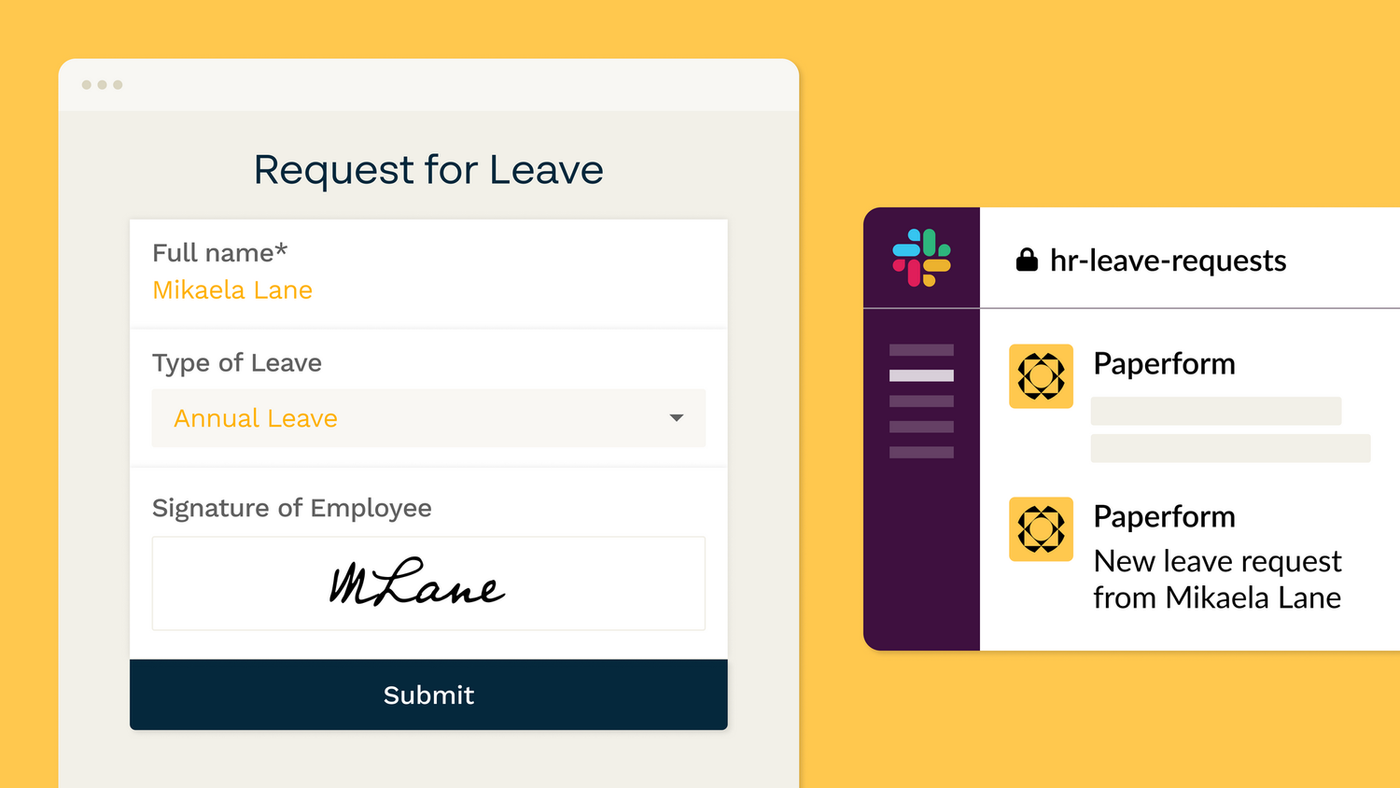
Paperform stands out with its robust integration options. Whether you’re looking to connect with CRMs, email marketing platforms, payment processors, or other productivity tools, Paperform’s integration capabilities ensure a seamless workflow, enhancing the efficiency and effectiveness of your data collection processes.
Customer-centric approach
One of Paperform’s core strengths is its commitment to user experience. This is evident not just in the platform's design but also in its approach to customer support.
With a focus on providing personalized and responsive support—and a CSAT rating of 97.4%—Paperform ensures that you have the assistance you need, when you need it, making the process of creating and managing forms as smooth as possible.
Every single person I’ve talked to is friendly and knowledgeable. Every time I have a question, I get somebody who decides to stay invested until we’re done.
See how Paperform helps customers achieve their goals:
- How Little Wings Farm eliminated admin headaches with Paperform
- How The Well-Paid Expert uses Paperform to help solopreneurs grow
- How SYSTMS™ cut client onboarding from 6 hours to 15 minutes with Paperform
Unmatched flexibility

Paperform goes beyond traditional form-building, offering unparalleled flexibility to cater to a wide range of business needs.
- Payment pages: Process payments directly through your forms, turning them into efficient e-commerce solutions. Whether you're selling products, accepting donations, or managing event registrations, Paperform's payment pages make transactions smooth and professional.
- Booking forms: Schedule appointments and bookings effortlessly with Paperform. This features is perfect for service-based businesses, enabling clients to book sessions, classes, or appointments directly. Booking forms simplify scheduling and reduce the hassle of back-and-forth communication.
- Subscription services: If your business model includes subscriptions or recurring payments, Paperform’s tools are designed to handle these with ease. Set up subscription services directly through your forms, offering a seamless experience for both you and your customers.
- No-Code logic and calculations: Paperform’s advanced features include no-code logic and calculations, enabling you to create dynamic forms that change based on user responses. These features add an interactive element to your forms, enhancing user engagement and providing tailored experiences.
By using Paperform's wide array of features, you streamline how you work and get more value out of your subscription. Start with surveys, then build more solutions that solve your business problems.
If you're looking for a balance between engaging design, comprehensive features, and ease of use, Paperform might just be the right option.
It combines the strengths of both Typeform and SurveyMonkey, offering an intuitive platform with robust customization options, detailed analytics, and a wide range of integrations.
With Paperform, you get a versatile tool that adapts to your needs, backed by exceptional customer support. Try it yourself with our 14-day free trial.
Related reading
Form a better life now.
Get your 7 day unrestricted trialHere is the ultimate list of online form builders, what they do best, their pricing, and examples to...
Independent retailers are some of the smartest operators in small business—but they’re forced to wor...
Independent retailers are some of the smartest operators in small business—but they’re forced to wor...
The ultimate list of Black Friday and Cyber Monday SaaS deals for 2025